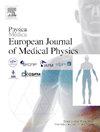Verification of Geant4-DNA step-by-step-reaction-diffusion master equation model for long-term radiolysis simulation
IF 3.3
3区 医学
Q1 RADIOLOGY, NUCLEAR MEDICINE & MEDICAL IMAGING
Physica Medica-European Journal of Medical Physics
Pub Date : 2025-05-01
DOI:10.1016/j.ejmp.2025.104983
引用次数: 0
Abstract
Purpose
This paper describes the verification of the step-by-step-reaction-diffusion Master Equation (SBS-RDME) model, implemented in Geant4-DNA, for long-term radiolysis simulations in the Fricke dosimeter.
Methods
Scaling for reaction rate constants due to the high acidity of the Fricke solution was applied. The secondary electrons generated by gamma irradiation from Co-60 were used as the radiation source for the simulations. Model parameters were optimized by observing changes in output and computation time in response to variations in the starting time t and initial voxel resolution ℎ of the compartment-based simulation. The yields of ferric ion G(Fe3+) and chemical species influencing its formation were calculated using the SBS-RDME model and using the IRT method for comparison. The time evolution of the yields of Fe3+, ![]() OH, H
OH, H![]() , HO2
, HO2![]() , H2O2, and H2 were compared, and the reactions affecting the yield of each chemical species were analyzed.
, H2O2, and H2 were compared, and the reactions affecting the yield of each chemical species were analyzed.
Results
The model parameters were set to t = 5 ns and h = 12.5 nm. The yield trends over time for chemical species were consistent between the SBS-RDME model and the IRT method. At 50 s, the G(Fe3+) from the two calculations agreed within 3.2 %. Contribution analysis of the reactions affecting the generation/removal of each chemical species indicated that the main reason for this discrepancy between the two calculations might be the inability of the SBS method to consider specific reaction types during simulation.
Conclusions
The SBS-RDME model was verified for long-term simulations by comparing its results to those obtained from the IRT method.
用于长期辐射分解模拟的Geant4-DNA分步反应-扩散主方程模型验证
本文描述了在Geant4-DNA中实现的逐步反应-扩散主方程(sds - rdme)模型在Fricke剂量计中的长期辐射溶解模拟的验证。方法对Fricke溶液的高酸性反应速率常数进行标度。利用Co-60辐照产生的二次电子作为辐射源进行模拟。通过观察模型输出和计算时间的变化来响应基于隔室的模拟的起始时间t和初始体素分辨率的变化,从而优化模型参数。采用SBS-RDME模型计算铁离子G(Fe3+)的产率和影响其形成的化学物质,并采用IRT法进行比较。比较了Fe3+、OH、H、HO2、H2O2和H2的产率随时间的变化规律,并分析了影响各化学物质产率的反应。结果模型参数设为t = 5 ns, h = 12.5 nm。SBS-RDME模型和IRT方法对化学物种的产量随时间的变化趋势一致。在50 s时,两种计算得到的G(Fe3+)在3.2%以内一致。对影响每种化学物质生成/去除的反应的贡献分析表明,两种计算之间存在差异的主要原因可能是SBS方法在模拟过程中无法考虑特定的反应类型。通过将SBS-RDME模型的结果与IRT方法的结果进行比较,验证了该模型的长期模拟效果。
本文章由计算机程序翻译,如有差异,请以英文原文为准。
求助全文
约1分钟内获得全文
求助全文
来源期刊
CiteScore
6.80
自引率
14.70%
发文量
493
审稿时长
78 days
期刊介绍:
Physica Medica, European Journal of Medical Physics, publishing with Elsevier from 2007, provides an international forum for research and reviews on the following main topics:
Medical Imaging
Radiation Therapy
Radiation Protection
Measuring Systems and Signal Processing
Education and training in Medical Physics
Professional issues in Medical Physics.

 求助内容:
求助内容: 应助结果提醒方式:
应助结果提醒方式:


